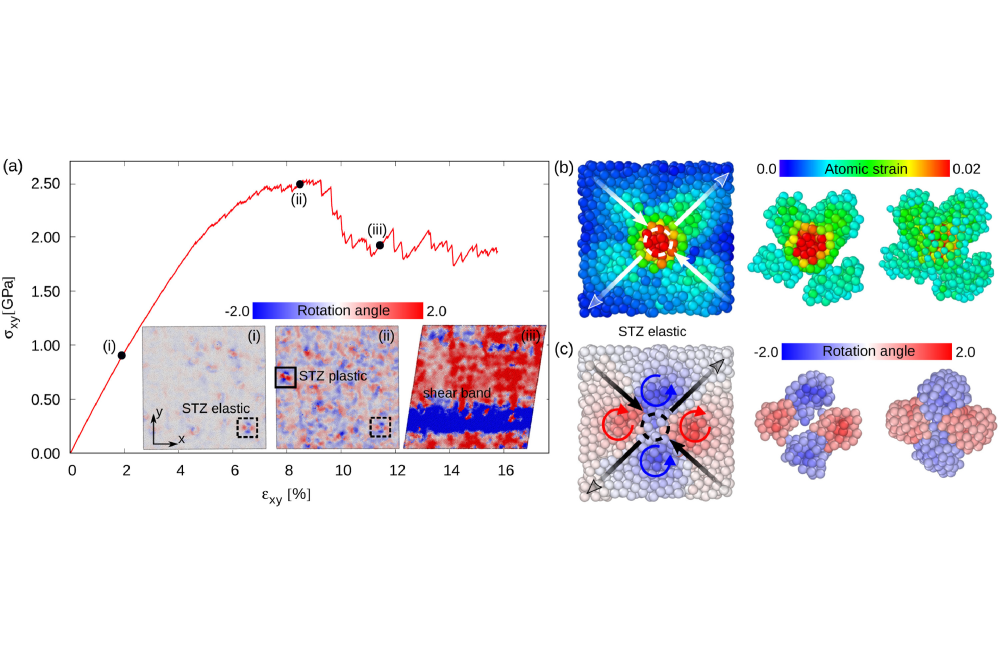Deformation Phenomena in Metallic Glass/High Entropy Nanolaminates
Einleitung
The application of metallic glasses (MGs) is limited by their brittle behavior at room temperature [1]. In order to underpin the potential of using MGs as structural materials, the shear bands generation and propagation from elastic excitation to plastic deformation must be further investigated. However, due to the spatial and temporal confinement [2], the dynamics of shear banding are typically difficult to study and even the most sophisticated atomistic simulations method could not perfectly establish a universal structure-plasticity picture. Hence, the atomic-level mechanism of elastic to plastic transition and, moreover, the effect of structural or stress fluctuations on the propagation of shear bands are still open for discussion.
Methoden
In order to study the atomic-level mechanism of shear band propagation and remove the thermal noise effect, the deformation of monolithic Cu64Zr36 MG was investigated by performing athermal quasi-static (AQS) simulations. Furthermore, the structure and the stress modulated MG heterostructures were designed and deformed to investigate the effect of structural or stress fluctuations on the propagation of shear bands. The Cu64Zr36 MG system was relaxed at different temperatures starting from 50K up to the melting temperature with a temperature increment of 50K. In this way, the change of the structure and the stress states with temperature can be systematically investigated. Molecular dynamics (MD) simulations were conductedusing the LAMMPS software [3]. The deformation mechanisms were monitored using atomic the local entropy- based structural identification, von Mises strain and stress and the sign of rotation angle calculated and visualized using the OVITO analysis and visualization software using the python scripting interface [4].
Ergebnisse
The first aim of this project was to disclose the atomic-level mechanism underlying elastic and plastic deformation in MGs. By simulating athermal quasistatic shearing processes, we concluded that shear transformation zones (STZ) start to activate from a very early stage of loading (see Fig. 1 a) and the variation in their magnitude defines the boundary between elastic and plastic events. During loading, elastic heterogeneities undergo a continuous distortion that generates small strain variations and elastic excitations. Eventually, the elastic events exceed the local yield stress and the energy overcomes the barrier for large plastic strain. In general, during STZ activation the complex strain and the corresponding directional rotation fields display quadrupolar distributions (Fig.1 b-c) with long-range signatures that overlap to some extent, constraining the atomic rearrangement during plastic, and even elastic unloading.
As the propagation of a shear band is a stress-driven process [5], we designed and tested the stress-modulated heterogeneity MG structures. The correlation between the deformation behavior and the effect of stress and structure heterogeneities in MGs was investigated. In general, strain hardening together with enhanced tensile ductility in monolithic MGs can be attained by only modulating the internal stress state without changing their local structure. The stress heterogeneity caused by the residual stresses can change the shear band dynamics leading to the formation and interaction of multiple shear bands, which consequently enhances the deformability. Moreover, the residual compressive stress offsets the external tensile stress, which delays shear band formation and, therefore, is responsible for efficient strain hardening and toughness.
Through systematic control of the annealing parameters, we have been able to simulate MGs resembling structures usually obtained by quenching at cooling rates used in the melt spinning process. Density, local order, and local entropy calculations predict MGs with structures prepared at cooling rate orders of magnitude lower than those typically realized in atomistic modeling. Hence, annealing above Tg is an alternative to melt quenching simulations and offers the prospect of modeling well relaxed glassy structures that were not achievable before in molecular dynamics simulations.
Diskussion
Firstly, we reveal a novel and more complete perspective of STZ formation and evolution highlighting its Eshelby-like inclusions characteristics. The novel picture of STZs could pave the way towards developing better tools to understand and control the structure-property relationship in MGs. Moreover, this approach allows to resolve the three-dimensional structural evolution of the complex STZ-vortex unit down to the atomic scale and to deepen the understanding of the fundamental deformation mechanisms of MGs from small elastic excitations to macroscopic plasticity. Secondly, our simulation result indicates that the strain-hardening of MGs can be achieved by only designing the internal stress state without changing its structure. The fact that MGs can overcome shear-softening mechanical behavior and achieve strain hardening and extensive ductility at room temperature without affecting structural order underpins the potential of using MGs as structural materials. Finally, we managed one critical issue associated with high cooling rates used to model MG structures. By systematically controlling the annealing temperature and time MGs with structures equivalent to those obtained by quenching at cooling rates used in melt spinning processes could be simulated.




